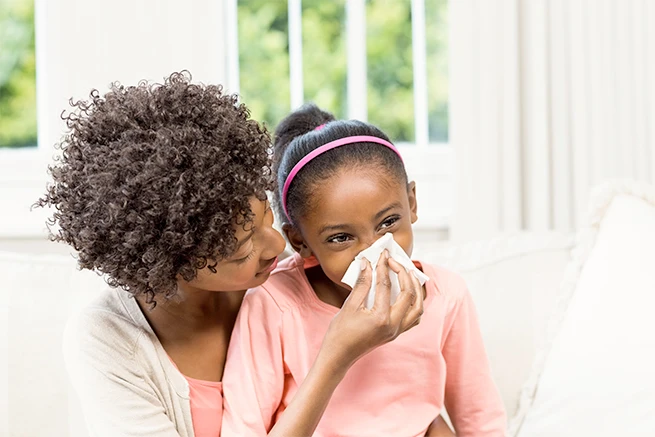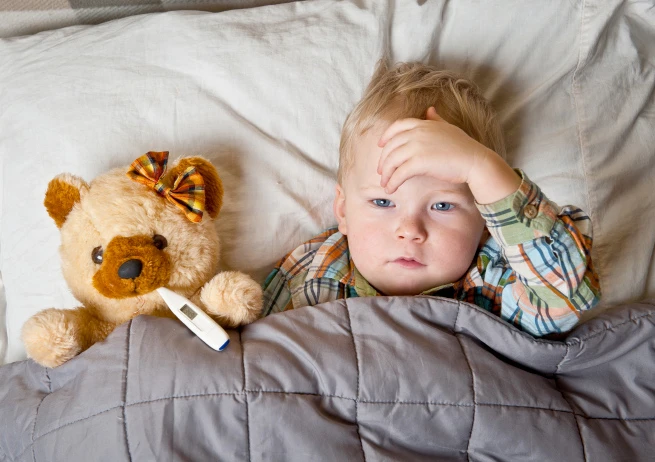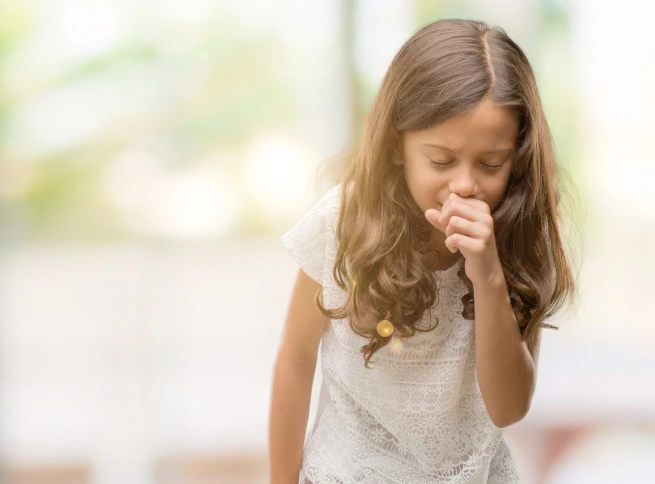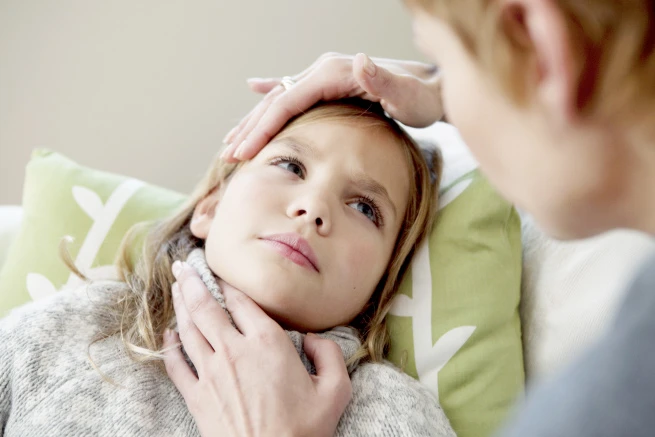Blocked nose and nasal congestion causes
Blocked noses and congestion in children are usually caused by an infection or allergy. Knowing what causes a blocked nose can help you to provide the right treatment.
Infections
Infections (viral or bacterial) can cause nasal passage membranes to become inflamed and trigger a runny or blocked nose. There are many different infections that may cause this.
Colds - A stuffy nose is one of the most common symptoms of a cold. Colds are infections caused by any one of hundreds of viruses targeting the respiratory system. Cold symptoms your little one may experience alongside their blocked nose are coughs, sneezing, fever, mucus build-up, tiredness, sore throat, headaches, and swollen sinuses.
Dawn Kelly, a health visitor lecturer and mother-of-three, says: “Given there’s around 200 cold viruses, babies can get around eight to nine coughs and colds a year, and can be blocked up with each different virus. They can also sound much worse than they are as they have such tiny nasal passages.”
This content was written by healthcare professional Dawn Kelly in 2020. She was paid for her time but does not endorse CALPOL® Products.
Flu - The flu is a viral infection that can sometimes cause congestion. Other flu symptoms to watch out for are a fever, aching, tiredness, a dry cough, sore throat, headache, not being able to sleep, off their food, upset tummy or being sick.
Sinusitis - Sinusitis often follows a cold, and can cause a swelling of the sinuses leading to a bunged-up feeling. As well as a blocked or runny nose, it can also cause pain or tenderness in the cheeks, eyes, forehead, head and teeth. Sinusitis can also affect your little one’s sense of smell, give them a high temperature, produce bad breath, cause irritability, difficulty feeding, and breathing through their mouth. Sinusitis and other respiratory tract infections can sometimes be caused by bacteria, instead of a virus.
Bronchiolitis - This infection affects the lower respiratory tract – part of the lungs. It’s quite common in children under two and can result in a runny nose. It usually starts off like a common cold before developing symptoms like a slight temperature, dry and persistent cough, difficulty feeding and rapid or noisy breathing (wheezing).
Mucus build-up
Sometimes babies younger than six months will get the “snuffles”. A baby is usually snuffly because they have a build-up of mucus in their tiny noses and narrow nasal passages and can’t clear it themselves. If your baby seems otherwise well, it probably has nothing to do with an infection.
Allergies
Hay fever and other allergies can also cause congestion. These can last a long time – sometimes over a year – depending on what they are allergic to. A simple way that can help identify that the congestion is caused by an allergy rather than a cold is by checking the colour of the mucus coming from their nose. If it is clear and watery, it’s more likely to be an allergy.
Obstructions
Never overlook the possibility that a nasal blockage can be caused by a curious child putting something in their nostril. If you think this is the case, seek medical advice immediately.
What causes a blocked nose at night?
For many children, nasal congestion can become worse at night. This is because lying on their back causes mucus to pool at the back of their throats. Plus, their immune system is typically more active at night, which could increase any swelling.
How long will a blocked nose last?
If caused by a cold, a blocked nose will usually get better in 5 to 7 days, but can take up to 2 weeks in small children. A blocked nose in children or babies will usually clear within two or three weeks if the underlying infection is caused by sinusitis or bronchiolitis, and around a week for flu. If your little one has developed an allergy, they may have congestion for many months at a time. In this case, it is best to speak to your GP and investigate what might be causing it and what treatment options are available.
Dawn adds: “Most cases of nasal congestion in babies and toddlers will clear up on their own within a couple of weeks. They can come and go within that time. If the sniffles last longer than that or you have any concerns, make sure you speak with your GP.”
This content was written by healthcare professional Dawn Kelly in 2020. She was paid for her time but does not endorse CALPOL® Products.
Treatment for nasal congestion
There are a few home remedies and treatments that you can use to help clear a baby’s blocked nose and reduce congestion. It’s important to know if the underlying cause of the congestion or blocked nose is from a virus, bacterial infection or allergy when considering what you might do to help.
Viral - Most cold viruses will disappear after two weeks, so you’re really just trying to make your little ones more comfortable and breathe better until then.
Bacterial- With a bacterial infection, your child might need antibiotics. Speak to your GP about this.
Allergies - For allergies, you’ll need to speak with your GP regarding the best treatment for that specific allergy.
There’s no simple cure for the blocked nose itself but there a few things you can do to make your little one more comfortable. From saline solutions to humidifiers, we run through our treatments and home remedies for blocked noses in babies and children.
Saline sprays or drops
Saline helps to thin the mucus blocking your child’s nose and make it easier for your little one to clear any congestion. You can buy saline sprays or drops from your local pharmacy, where pharmacists can also advise on how to use them. If saline is used too often, it could cause a bit of soreness to the skin around the nose.
Dawn says: “The key is to try and keep nasal passages as clear as possible. Saline drops can help loosen it up, while older kids can try nasal sprays to clear things out.”
This content was written by healthcare professional Dawn Kelly in 2020. She was paid for her time but does not endorse CALPOL® Products.
Top tips on using a nasal spray and drops
Nasal sprays and drops can be used in older babies and children. Get the most from them with our tips:
Get the timing right. Timing is everything. It’s hard to use when your little one is feeling wriggly, so try when they are nice and relaxed, like after a bath.
Lay their head back. Get them to lay on their back with their head tilted back. For little ones, wrap them in blankets to keep them from wriggling.
Let it do its work. After using the spray or drops, keep them reclined for a few minutes otherwise the saline could run out.
Don’t worry about misfires. If you get a little spray in their eye, don’t panic. It may surprise them a little but saline solution is very gentle and shouldn’t cause any harm.
Calpol has a range of saline drops and sprays available
Home remedies for blocked noses
Try and make your little one as comfortable as possible and help them to reduce nasal congestion with a few home treatments.
Steam. Sit in a steamy atmosphere before a feed or when reading to your children. For example, sit in the bathroom with the shower running and the door closed for five minutes.
Drinks. Give them plenty of fluids. For little ones, make sure they are feeding regularly, and for older children, offer warm broth or soup.
Humidifiers.
Put a humidifier in their bedroom to help raise the humidity in the air. This will help to moisten their nasal passages.
Nasal bulbs or aspirators. These can help suck out some of the mucus to help them breathe easier.
Menthol vapours, rubs and pastilles. These can provide soothing scents such as eucalyptus and mint that can help them breathe a little easier.
Dawn says: “Keep the nose as clean as possible with soft wet cloths and if they have a temperature that’s making them grisly and unsettled, try some paracetamol to help them feel better.”
This content was written by healthcare professional Dawn Kelly in 2020. She was paid for her time but does not endorse CALPOL® Products.
When to call the doctor
A child with a blocked nose usually just needs a few cuddles, and lots of rest, but you should call 999 or go to A&E if your child:
Struggles to breathe
Coughs or chokes after a feed
Has a cough associated with any skin colour change such as turning blue
Seems out of breath
Cannot talk or eat
Has something stuck in their nose or throat
The information on this page is not exhaustive. You know your child best, if you have any concerns, you should contact your GP.
Home remedies for blocked noses
Steam. Sit in a steamy atmosphere before a feed or when reading to your children. For example, sit in the bathroom with the shower running and the door closed for five minutes
Drinks. Give them plenty of fluids. For little ones, make sure they are feeding regularly, and for older children, offer warm broth or soup.
Humidifiers. Put a humidifier in their bedroom to help raise the humidity in the air. This will help to moisten their nasal passages.
Nasal bulbs or aspirators. These can help suck out some of the mucus to help them breathe easier.
Menthol vapours, rubs and pastilles. These can provide soothing scents such as eucalyptus and mint that can help them breathe a little easier.

Health Visitor
Dawn Kelly
Dawn is a qualified paediatric nurse, health visitor and lecturer with over 25 years’ experience. She’s written widely about child health and development and has a wealth of knowledge about childhood illnesses and advising parents on issues such as weaning and sleep. Her three daughters also put her knowledge to the test!
This HCP does not endorse Calpol.



